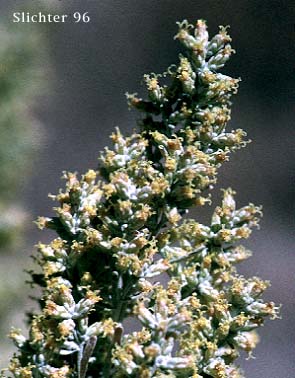 The photo
at right shows the inflorescence of big sagebrush (ssp. tridentata) as seen from Ana Reservoir,
near Summer Lake, OR....9/28/96.
The photo
at right shows the inflorescence of big sagebrush (ssp. tridentata) as seen from Ana Reservoir,
near Summer Lake, OR....9/28/96.
Big sagebrush is an aromatic, woody shrub, freely branched above, from 4-30 dm tall. Young stems are silvery-gray, while the older stems become grayish brown. The oldest stems have bark which is noticeably shredded.
The leaves are gray, crowded and narrowly cuneate with 3 rounded teeth or lobes on the blunt tip. They are silvery green above and below and strongly scented. The leaves alternate on the stems, and they may be both deciduous and winter persistent.
The flower heads are loosely spread out along the tips of the branches. The flower heads are soley discoid with 3-8 flowers per head. Big sagebrush flowers from late summer into fall.
ssp. tridentata: Plants generally over 1 meter high. Plants have a rounded, irregular apearance. The inflorescences begin at various levels and rise to various heights.
ssp. vaseyana: Shorter than 1 meter in height. Plants have a flat-topped appearance with most of the numerous inflorescences arising to about the same height. Leaves 1-3 cm long. This species is found from thefoothills to well up into the mountains, often between 1600-2300 meters.
ssp. wyomingensis: Shorter than 1 meter in height. Plants have a rounded, irregular appearance. Leaves mostly 1-2 cm long. This variety is generally found in the plains in the foothills, but may be found occasionally up to 2700 meters.
Sagebrush was used by Native Americans for shelter, cordage, and basketry. The fruits were used fresh, dried, or pounded into a meal. As browse, it is lightly used by deer.
Big sagebrush may be found on dry hills and plains, but may extend up to timberline in open habitats. Big sagebrush is often found on rocky and gravelly basaltic soils, and has a special affinity to granitic substrates.
Big sagebrush may be found east of the Cascades and Sierra Nevada, covering the dry plains of western North America.